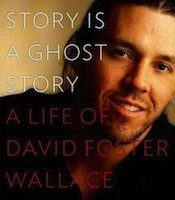Like many latecomers to his work, my introduction to David Foster Wallace began with a reading of his 2005 Kenyon College commencement address. I remember being struck initially, immediately, by its honesty, its rhetorical courage, its compassion. When Wallace advised the graduating class that a little conscientiousness could go a long way in countering boredom, even depression, I was moved. When I learned the same man had committed suicide just a few years after delivering that speech, I could hardly believe it.
In Every Love Story is a Ghost Story: A Life of David Foster Wallace, the first full biography on its subject, D. T. Max provides an insightful probe into the tumultuous life of a man whom The Guardian once hailed as “the most brilliant American writer of his generation.” Chronicling Wallace’s “happy and ordinary” childhood years in Champaign-Urbana, Illinois through the “unendurable pain” that led Wallace to hang himself in 2008 at the age of 46, Max reveals the range of human complexity lurking behind Wallace’s oft beatified public image.
His early years, as D. T. Max describes them, were fairly idyllic. The eldest child of happily married, college-educated parents, Wallace grew up in a household that he considered “a perfect, smoothly running machine.” Dinner was at 5:45; bedtime was at 8:30. Before bed, the children spoke privately with their mother–”the center of [David’s] universe.”
But Wallace’s blissful youth wasn’t meant to last. By the time he was nine or ten he felt, as he would later write, the “First occasion of ‘Depressive, clinically anxious feelings.’” While a student at Amherst, Wallace began taking anti-depressants; but his ambivalence toward the medication led him to relapse periodically throughout his life.
Max’s biography is most compelling when it engages with Wallace’s work. According to Max, Wallace’s first novel The Broom of the System combined his passion for the relativistic language philosophy of Ludwig Wittgenstein—”Uncle Ludwig” —with his enthusiasm for the postmodern novels of John Barth, Don DeLillo and Thomas Pynchon. Skillfully distilling Wallace’s philosophical influences, Max describes how he forged a literary style separate both from the postmodern novels he grew up with and the dominant strands of realism and Carver-esque minimalism.

When Infinite Jest, his second novel, was published seven years later, it was clear Wallace had changed—not only as an artist, but as a man. Max notes that the time Wallace spent in rehab earnestly struggling to recover from alcoholism had made him weary of the postmodern obsession with irony. Though undoubtedly entertaining, he believed “irony was defeatist, timid, the telltale of a generation too afraid to say what it meant.” Worse, by adopting postmodernist irony, Wallace saw television transforming America into “a nation of addicts.” In Infinite Jest, Wallace took aim at the consumer culture he distrusted; the novel’s “fragmentary structure” sought to challenge readers accustomed to mere “spectation.” By creating “a novel you keep having to reread to understand,” Wallace wanted “to help the reader to a more engaged life.”
Although he hanged himself before he could finish his third novel, posthumously published as The Pale King in 2011, Wallace had accomplished more in his 46 years than most writers do in a lifetime. His novels, in addition to his acclaimed short story and essay collections, inspired faith in literature’s ability to defy “the corruptions of the adult world.”
While eager to chronicle Wallace’s struggle to become a literary “apostle of sincerity” (Max’s words), Every Love Story is a Ghost Story is also commendable for framing Wallace’s positive pursuits beside his distinctly less than angelic personal life. As addicted to women as he was to weed, Wallace once lamented that his destiny in life was to “put my penis in as many vaginas as possible.” And even when the girl stuck, his relationships inclined toward the dramatic. See Wallace v. Mary Karr: in his vigorous attempts to woo the poet, Wallace not only got “a tattoo with her name and a heart,” but seriously considered murdering her estranged husband.
D. T. Max’s biography, constructed from Wallace’s letters and from conversations with people who knew him, is full of interesting tidbits like this—revealing windows into the morally hazy world of a writer often treated like the sacred cow of the literary establishment. Max’s exploration of Wallace’s love/hate relationship with drugs, television and fame; his failed dabbles in religion; and his candid correspondence with literary pals Jonathan Franzen and Don DeLillo—to name just a few of the book’s highlights—attaches flesh to the porcelain saint Wallace is often mistaken for.
Even so, Every Love Story is a Ghost Story is clearly the biography of a supporter, and Max’s enthusiasm for his subject occasionally interferes with his ability to distill it fairly. For Max, Wallace’s “galloping mind,” “his brilliant mind,” “his outsized intelligence,” “his stunning energy,” become less subjective judgments than axiomatic truths poured in adamantine; he’s hard-pressed to even consider the alternative. In the end one gets the sense that Max, who admits to having “had this long love affair with David,” is straining to convince the reader to love him, too—an ironic strategy given Wallace’s disdain for advertisements.
The biography is, in other words, a fairly generous portrait of the artist. The books’ intended audience, as Max stated, are people already interested in Wallace, and the book seems unlikely to attract much of anyone else. Though it is undoubtedly well-researched, Max’s tendency to indulge his inner fanboy—at one point penning four long sentences about Wallace’s discovery of the word “shunt”—will often leave the casual admirer feeling exasperated. But if you’re a true D.F.W fan, there’s much here to be savored. Max’s depiction of Wallace’s life and untimely death will leave you wondering what could have been.




